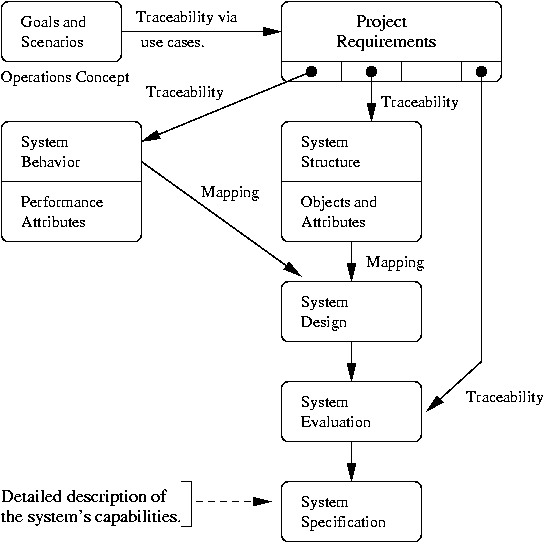|
Enhanced Systems Engineering Management through
Design/Requirements Representations Connected by Mappings and Traceability
-
Figure 1 shows the primary tracks of traceability for the
development of a system-level product.

Figure 1. Traceability Mappings for the Development Pathway,
Goals/Scenarios through Eystem Evaluation.
For system-level design, traceability begins with the connnection
of goals and scenarios with use cases. It links the requirements
and specifications with models of system behavior, system structure,
and procedures for system evaluation.
Management of Complexity through Orthogonalization of Design Concerns
-
Emphasize function-architecture co-design.
System design alternatives are created by mapping models of system
behavior onto tentative system structures.
System evaluation and ranking/optimization procedures eliminate
the inferior solutions.
![[System Pathway2]](images/system-pathway2.gif)
Figure 2. Evaluation, Ranking,
Optimization and Trade-Off Analysis for System Design Alternatives
-
In the design of complex engineering systems,
"orthogonalization of concerns" simplifies the
difficulty in exploring the space of design alternatives.
|
![[Left]](images/button-left.gif)
![[Up]](images/button-up.gif)
![[Right]](images/button-right.gif)
![[Left]](images/button-left.gif)
![[Up]](images/button-up.gif)
![[Right]](images/button-right.gif)
![[Left]](images/button-left.gif)
![[Up]](images/button-up.gif)
![[Right]](images/button-right.gif)
![[Left]](images/button-left.gif)
![[Up]](images/button-up.gif)
![[Right]](images/button-right.gif)
![[Left]](images/button-left.gif)
![[Up]](images/button-up.gif)
![[Right]](images/button-right.gif)